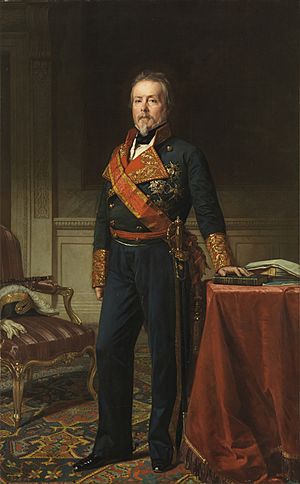Evaristo Fernández de San Miguel facts for kids
Quick facts for kids
Evaristo Fernández de San Miguel, duque de San Miguel
|
|
|---|---|

Evaristo Fernández de San Miguel, duque de San Miguel, 1854. Federico Madrazo (Museo del Prado, Madrid)
|
|
| Born | 26 October 1785 Gijón (Asturias), Spain |
| Died | 29 May 1862 (aged 76) Madrid, Spain |
| Service/ |
Spanish Army |
| Rank | Captain general |
| Battles/wars | Peninsular War (several battles) |
Evaristo José Fernández San Miguel y Valledor, also known as the Duke of San Miguel (born October 26, 1785 – died May 29, 1862), was an important Spanish soldier, politician, and writer. He lived during a time of big changes in Spain.
He served as a representative in the Spanish Parliament, called the Cortes Generales, several times. He was also made a Senator for life in 1851. Later, in 1856, he became a Captain General, which is a very high military rank.
Contents
Military Life and Adventures
Evaristo studied math in Gijón and humanities in Oviedo. In May 1805, he joined the Army as a cadet. His brother, Santos, also joined and later became a lieutenant general.
When the Peninsular War began, Evaristo was a sub-lieutenant. This war was when Spain fought against French forces led by Napoleon. Evaristo was in Madrid, defending a position, but had to leave when many French soldiers attacked.
He then went back to Asturias to help with the defense plans there. In July 1809, he was captured after a battle and sent to France. He was held prisoner until 1813.
After returning to Spain, he joined a regiment that was preparing to go to America. Their mission was to stop rebellions there.
A Fight for Freedom
Evaristo was a lieutenant colonel in 1819. He was part of a group of officers who wanted a more liberal government in Spain. He was arrested with other officers, including Antonio Quiroga Hermida. They were held in the Castle of San Sebastián in Cádiz.
In January 1820, Evaristo and his friends managed to escape. This happened just a week after Rafael del Riego started a military uprising, known as a pronunciamiento. This uprising aimed to bring back a liberal constitution.
Evaristo was put in charge of a special mobile column of soldiers. This group traveled through Andalusia to gather support for the revolution.
The Liberal Years
During a period called the Trienio Liberal (1820-1823), Spain had a liberal government. Evaristo was very active in Madrid. He often went to tertulias, which were like meeting places in cafes. People would gather there to discuss new ideas and politics.
In July 1822, royal guards tried to overthrow the liberal government. Evaristo led a group called the Batallón Sagrado (Sacred Battalion). They went to the city council to ask for weapons to defend Madrid.
He later joined forces with Francisco Espoz y Mina in Catalonia. In October 1823, he was wounded and captured in a battle. Thanks to a French Marshal, he was taken to Agen. In May 1824, he was released but had to leave Spain. He went to London.
He tried to return to Spain in 1830 but couldn't until May 1834. In July 1836, he was promoted to brigadier after fighting in the Battle of Mendigorría. He was wounded again and received a special award called the Laureate Cross of Saint Ferdinand.
As a general, he also led an attack against Carlist forces in Cantavieja and Beceite. The Carlists were a group who supported a different royal family for the throne.
His Writings and Journalism
Evaristo Fernández de San Miguel was a very active writer. He wrote many books and articles. He also wrote the words for the Himno de Riego. This song honored Rafael del Riego and became Spain's national anthem in 1822. It was also a popular song during the First Spanish Republic and the Second Spanish Republic.
While in San Fernando, he helped create a patriotic newspaper for the army. He also wrote the public announcements for Riego's uprising.
In 1821, he started his own important liberal newspaper called El Espectador. While he was exiled in London, he wrote for other newspapers. He also published a book in 1826 called Elementos del arte de la guerra (Elements of the Art of War).
See also
 In Spanish: Evaristo Fernández de San Miguel para niños
In Spanish: Evaristo Fernández de San Miguel para niños

